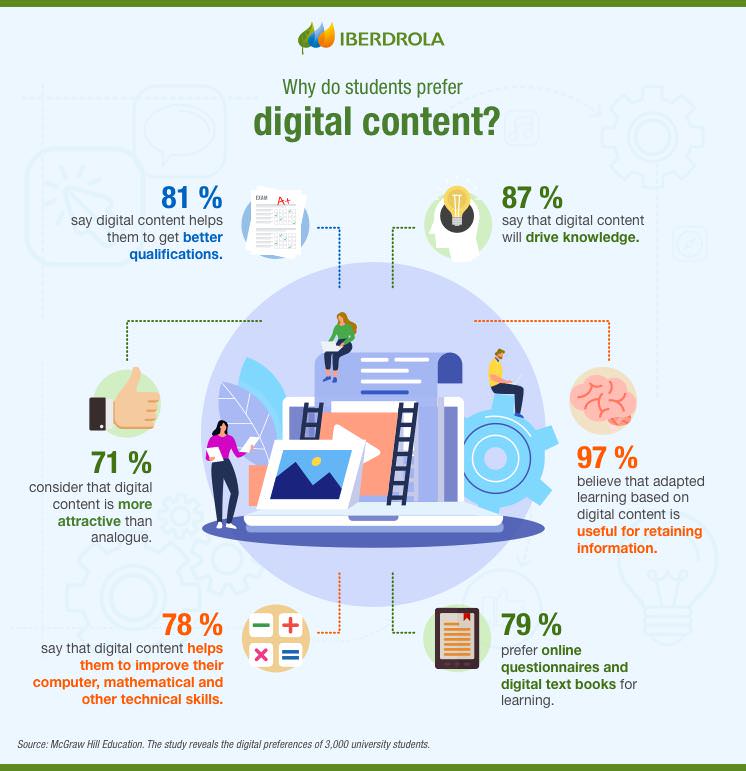What is educational technology
EdTech, the advantages of using technology in education
Society High performance Digital talent
Alongside the digital revolution, the education sector has seen far-reaching changes in the last decade, creating a new reality in classrooms. Along with a boom in Educational Technology (EdTech), an infinite number of tools and applications have emerged and have become part of students' and teachers' daily lives. They are tools capable of providing students with tailor-made learning experiences.

Just ten years ago, digital scenarios were rarely seen in education settings. 'Blackboards' were still green, books were made of paper and examinations were done by hand. However, today because of the COVID-19 pandemic - the disruptive education that so many experts had been crying out for has brought Educational Technology (EdTech) into classrooms everywhere.
Whay is educational technology. Objectives
According to the Educational Innovation Centre of the prestigious Tecnológico de Monterrey, - a Mexican organisation that identifies and analyses high-impact trends in education - the EdTech concept can be divided into two branches: the academic area, defined as "the possibility of studying, analysing and revising teaching and learning processes from a technological perspective"; and; the practical area, "which deals with technology used in educational contexts".
When both branches are combined, EdTech might be said to be the practical application of Information and Communication Technologies (ICT) to enhance learning, because if there is one thing that most experts agree on, it is that the use of technology in education is the means. This opinion is shared by Trine Jensen, head of ICT strategy at the International Association of Universities (IAU), created under the auspices of the UNESCO in 1950: "Technological progress is not an end in itself, but rather a means for configuring the future of society".
Although the boom in EdTech is happening almost everywhere in the world, its implementation is not equal due to digital divide — an imbalance between those who have access to technology and those who don't. Despite this inconvenience, all forms of educational technology - apps, platforms, tools, devices, etc. - clearly have numerous benefits.
Advantages and disadvantages of technology in education
Technologies in education, many of which are still being developed, are tools and apps for creating content, platforms for sharing and interacting, innovations such as virtual reality, 3D printing and video games, such as the famous, pioneering Massive Online Open Courses (MOOC), digital books and notebooks mobile learning, etc. Together, they paint a picture of the new reality in the classrooms, with its advantages and drawbacks.
Advantages
- They create learning environments aligned with modern times, allowing digital immersion.
- They make personalised study possible, tailored to each student's learning speed and conditions.
- They provide educational opportunities without geographical barriers and give access to diverse information.
- They are highly motivating and immediately reveal areas for improvement.
- They open the way to more experiential, practice-based training.
Drawbacks
- They can lead to over-dependence on technology and dehumanise education.
- Technology is not 100% inclusive, because not all students have the same access to the necessary resources.
- They can hinder the development of certain analogue skills, such as handwriting, and the development of other cognitive skills such as critical thinking.
- They cause more distractions during learning, which can also be superficial unless the proper information is selected.
- They can exacerbate socialisation problems by causing a certain degree of isolation.

SEE INFOGRAPHIC: Why do students prefer digital content? [PDF]
The most popular 'Edtech' platforms. Tools and aplications
An educational platform is a website that contains different apps and tools optimised for teaching purposes such as assignments, chats, forums, videos, games, questionnaires, blogs, etc. They are used to create and manage entire courses at all levels, from basic to university. There are an infinite number of EdTech platforms; however, considering their global implementation and number of users, these are some of the most popular:
- Google Classroom. Designed to enable teachers to organise their students' academic programme. It has functions for sending assignments, doing exams, marking projects and staying in close contact with students, among other things.
- Moodle. Moodle was one of the pioneers and is still one of the best known. It takes a collaborative and interactive approach, and aims to make both students and teachers an essential part of the learning system.
- Chamilo. As well as managing virtual learning, it can be used to give classes in person or partly in person. It has facilities for holding video conferences, assigning roles to class members, starting discussion groups and has its own social network for learning.
- Schoology. This system is specifically designed for creating academic content and monitoring student progress. The basic functions include reproduction of multimedia material and creation of new content, as well as statistical reports on activities and evaluations.
- Duolingo. The platform par excellence for learning languages since its creation in 2011. It currently has more than 40 languages to learn, including languages with many speakers such as Japanese, others with few users such as Irish and finally languages of television products such as, for example, High Valyrian from Game of Thrones.
As well as having a range of general functions, it has other more specialised features: Flipgrid, for video; Hyperdocs, for interactive documents; and Edmodo, which has a profile for parents and focuses primarily on gamification, among other things.




